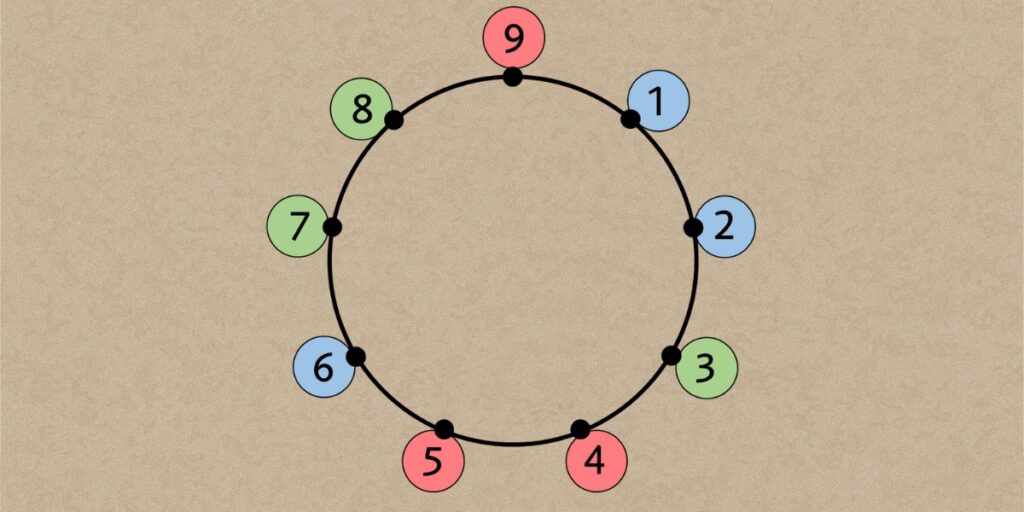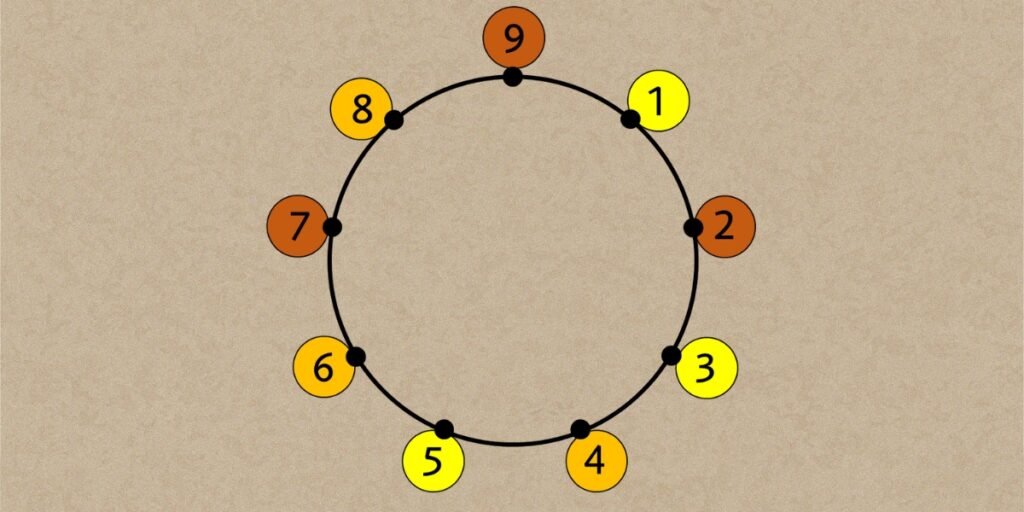Explore the transformative world of Enneagram Triads, a key tool for personal development and achieving profound self-understanding. Uncover the potent dynamics of Enneagram Triads and enrich your journey of personal development by combining the different Triads. Enneagram Triads offer a compass for personal development, leading you toward deeper self-awareness and growth and bringing insight into your role as a teacher, coach, leader, partner, etc.
Understanding Triads: A Key Concept in the Enneagram
Demystifying the Enneagram Triads offers an in-depth analysis, providing a foundation for self-discovery. These sets of three provide a rich understanding of our behaviors, motivations, and the patterns that shape our existence and motivational drivers.
The Enneagram Triads offer analytical insights into our behaviors and motivations, serving as effective tools for transformation and personal development.
The Enneagram Triads serve as a tool for personal development, illuminating the not-so-visible aspects of ourselves. By exploring these triads, we can unravel our characteristics and tendencies, offering actionable steps toward transformation and growth.
(Understand how your blind Enneagram Type can strengthen how you use your primary Enneagram Type)
Each triad helps you to understand different perspectives of the nine Enneagram types, and when used together, triads will become a precise map of your personality, helping you to find your type more precisely and understand your primary and blind types better, and the triads can help you understand the inner dynamics of the Enneagram itself and the dynamics between the types.
What is a Triad?
In the Enneagram, a triad is a grouping of three types with common characteristics, drivers or responses. One of these groupings enables an in-depth understanding of your mental, emotional, and instinctual reactions. Another grouping reveals how we attend to or solve problems, another grouping is about our reactions to difficulties etc.
The most known traids are:
- The Basic or Three Centers Triad
- The Hornavian or Social Triad
- The Harmonic Triad
- The Object Relations Triad
- The Freuds Dynamic Traid
Triads are the building blocks in your transformation journey, guiding your self-awareness and personal growth within the Enneagram framework.
Unlocking the meaning of a triad in the Enneagram is akin to revealing a pathway to profound insights, unraveling previously hidden layers of your persona and interactions with the world.
The History of Traids in the Enneagram
The concept of triads in the Enneagram has a profound historical origin, tracing back to ancient philosophies and spiritual systems. These triads are the base for the work of Oscar Ichazo and illuminate the Enneagram’s unique amalgamation of psychology, spirituality, and philosophy.
In the evolution of the Enneagram, triads have come to represent significant aspects of personality structure. They served as a crucial method to understand the nine Enneagram types more profoundly and as a wisdom lineage back to Ichazo’s original teachings.
These triads underwent significant development and refinement over several decades. Contemporary scholars and practitioners have further expanded their understanding, cementing the triads as a central component of the Enneagram personal development and transformation system.
We use triads in everyday life, and one of such triads are the 1) Ethos, 2) Pathos and 3)9 Logos explained to us by Aristoteles and used in communication. We also see traids used in the educational system, using the triad of 1) Presenting Theory, 2) Practice and 3) Assesment and Reflection and Integration.
Use of Ethos, Pathos and Logos
Ethos: Establishing Credibility and Trust
Ethos refers to the speaker or writer’s ethical appeal or credibility. It’s about establishing trust and authority in the eyes of the audience. A communicator with a strong ethos is perceived as knowledgeable, trustworthy, and respectable. To build ethos, one must demonstrate expertise, experience, and a clear understanding of the topic at hand. This might involve citing qualifications, referencing reputable sources, or demonstrating a consistent integrity and respectability track record. However, ethos goes beyond just credentials; it’s also about how you present yourself. A respectful tone, a clear commitment to the truth, and a demonstration of good moral character all contribute to a strong ethos. When an audience believes in the speaker’s credibility, they are more likely to be open to the message being presented.
Pathos: Engaging Emotion for Connection and Persuasion
Pathos appeals to the audience’s emotions, seeking to evoke feelings that will lead to persuasion. Human beings are not solely rational creatures; emotions play a significant role in decision-making and attitude formation. By engaging the audience’s feelings, a communicator can connect on a deeper level, making the message more memorable and impactful. Pathos can involve storytelling, vivid language, and imagery that conjure up fear, excitement, sympathy, or any other emotion that might drive the audience toward the desired conclusion. However, pathos must be used responsibly. Manipulating emotions without a basis in truth or for unethical ends can damage credibility and lead to distrust. When used ethically and effectively, pathos can create a powerful bond between the speaker and the audience, driving home the message in a way that logic alone cannot.

Logos: The Role of Logic and Reasoning
Logos is the appeal to logic, using clear, rational arguments to persuade. It involves presenting data, facts, and a well-structured argument to appeal to the audience’s sense of reason. Logical appeals include the use of statistics, evidence, case studies, and logical reasoning to support the message. The key to effective logos is not just in presenting facts but in explaining why these facts matter and how they form a coherent argument for the speaker’s position. The audience should be able to follow the line of reasoning and understand how the conclusion is reached. However, even the most logical argument can fall flat if not presented in an engaging way or if the audience does not trust the communicator. That’s why logos is most powerful when combined with ethos and pathos.
In conclusion, the triad of ethos, pathos, and logos offers a comprehensive approach to effective communication. Ethos establishes the speaker’s credibility, pathos connects emotionally with the audience, and logos persuades through logical argumentation. Balancing these three elements allows communicators to craft messages that resonate deeply, persuade effectively, and stand the test of critical scrutiny. Whether you’re delivering a speech, writing an article, or engaging in a debate, understanding and applying these principles can elevate your communication to an art form, moving and persuading your audience in ways that are profound and lasting.
The Benefits of Understanding Enneagram Triads
Understanding the Triads in the Enneagram is like gaining a roadmap to personal growth and transformation. It gives you a clearer perspective on the central aspects of your psyche, enhancing self-awareness and guiding you toward practical and precise personal development.
- Allows for the identification of dominant and blind aspects of personality
- Aids in effective communication and understanding of others
- Helps to promote physical, emotional and mental wellbeing and self-regulation
- Assists in identifying potential growth areas
- Contributes to a well-rounded personal transformation journey
Triads also provide a balanced view of personality dynamics. By grouping types that share a common focus yet exhibit it in different ways, triads highlight the diversity within common human experiences. This understanding can dismantle stereotypes and deepen our appreciation of the complex nature of personality.
Moreover, triads serve as a practical tool for personal development. By identifying our triad, we can pinpoint areas for growth and develop strategies to balance our dominant tendencies. This holistic approach to self-improvement embraces both our strengths and challenges, guiding us toward a more integrated and fulfilling life.
Intro to some of the Enneagram Triads
Digging deeper into the essence of triads opens a multi-layered universe of human behavior patterns. Applying this knowledge will provide a profound insight into personal intricacies and a more balanced lifestyle.
Unveiling the complexity of triads through this beginner’s guide helps users understand their essence. It’s a stepping stone towards embracing the healing power of self-awareness and self-growth through Enneagram.
The Basic Triad or Three Centers
The Basic Triad, or the Three Centers, focuses on the essential elements of the Enneagram, embodying three fundamental elements of being: Instinctive, Feeling, and Thinking. These triads reveal the essence of our perception, orientation, and response to the world.
- Body, Instinctive or Body Types: Includes types 8, 9, and 1, and represents our intrinsic sense of survival, power, resistance, and resilience.
- Emotion, Feeling or Image Types: Includes types 2, 3, and 4, and represents our emotional responses, connections, self-narratives and motivations.
- Cognitive, Rational or Thinking Types: Includes types 5, 6, and 7, and represents our intellectual capacities, analysis, perspectives and planning.
The Hornevian Triad
Embarking on the journey of personal development, the Hornevian Triad serves as a guide or pointer, illuminating our behaviors, motivations, and responses. Based on the work of Karen Horney, the triad invites us to explore the unique ways we respond to the world: either assertively, compliantly, or withdrawingly.
This triad tells us about our reactions when achieving tasks, solving problems, cooperating, and how we meet our needs when interacting and relating to others.
- Assertive Types – Includes Type 3, 7 and 8 and represents the urge to move against others, initiate or engage to fulfill their desires and value independence and power.
- Dutiful Types – Includes Type 1, 2 and 6 and represents the urge to move towards or teaming up with others to meet their needs for connection, safety and value.
- Withdrawing Types – Includes Type 4, 5 and 9 and represents the urge to move away from others to be able to process impressions and to seek inner peace, serenity and a sense of personal integrity.
The Harmonic Triad
The Harmonic Triad in the Enneagram teaches individuals various strategies for approaching problems, conflicts and pressure. This triad showcases how all personality types contain a unique and harmonious path towards self-growth and transformation.
The nine Enneagram types express their traits during difficult times and can be expressed for a short or longer time.
- The Emotional Realness Types – Includes Types 4, 6, and 8 and represents the tendency to face conflicts and pressure with emotional intensity, confrontations, and expressiveness.
- The Competency Types – Includes Type 1, 3 and 5 and represents the tendency to face conflicts and pressure with objectivity, competency, efficiency and mastery.
- The Positive Outlook Types – Includes Type 2, 7 and 9 and represents the tendency to face conflicts and pressure by avoiding negative emotions, shutting down the relationship, and looking at the positive sides or possibilities.
The Object Relations Triad
The Object Relations Triad shines a light on the nature of our relationships and offers profound insights into personal transformation. We can foster healthier dynamics by understanding how we instinctively respond to others based on our core Enneagram number.
- Frustration Types – Includes Type 1, 4 and 7 and represents the energy or capability of frustration of knowing that things could be better than they are.
- Rejection Types – Includes Type 2, 5 and 8 and represent the energy or capability of rejecting of self and others.
- Attachment, Ambivalent or Confused Types – Includes Type 2, 7 and 9 and represents the energy or capability of not being certain and therefor seeking stability.
Peeling back the layers of the Object Relations Triad reveals our innate drive for connection, autonomy, or security. Each drive is intimately connected to a specific Enneagram number, influencing our interactions and decision-making processes.
The real power of the Object Relations Triad revolves around its capacity to revolutionize personal development. Grasping this triad enables us to challenge our unconscious patterns, clearing the path for more authentic connections and personal growth.
It is a triad activated in personal and professional relationships and can explain some of the dynamics between the Enneagram types and why we have unmet expectations of each other.
The Ego, Superego, and Id Triad
Probing the psyche with the Ego, Superego and Id Triad emphasizes the roles of these Freudian constructs within the Enneagram framework. Each number within this triad corresponds to one of these constructs, offering an in-depth self-examination tool.
- Ego Types – Includes Type 1, 3, and 5, where Type 1 and 5 compensate for a “missing” Ego, while Type 3 is called a double Ego-type.
- SuperEgo Types – Includes Type 4, 8, and 6, where Type 4 and 8 compensate for a “missing” SuperEgo, while Type 6 is called a double SuperEgo-type.
- Id Types – Includes Type 2, 7, and 9, where Type 2 and 7 compensate for a “missing” Id, while Type 9 is called a double Id-type.
Understanding the Ego, Superego, and Id Triad in the Enneagram provides a powerful stepping stone for personal growth. By identifying and deconstructing these internal dimensions, individuals can leverage this triad to unlock their inherent potential.
This is a lesser known Enneagram Triad, so let me give some short examples from the traid.
Type 1 and 5 are “missing” an Ego and compensate for this by identifying (or creating an Ego) around their rules or their knowledge, respectively. Type 3 is a double Ego-type and will maintain a complete Ego by saying things like “Of course, I am not great at speaking Spanish, but I am almost fluent in Italian.” reframing situations to keep the Ego intact.
The Imbalance of the Centers Triad
Delving into the Enneagram’s Imbalance of Centers Triad, one observes that it’s a lens to view our tendency to identify with one center and neglect another. By understanding this triad, we begin the journey of nurturing our wholeness.
- Imbalance Heart Center Types – Includes Type 3, 7 and 8 and represents the tendency to stay disconnected from emotions, empathy and and what could be called the intuition from the heart.
- Imbalance Head Center Types – Includes Type 1, 2 and 6 and represents the tendency to stay disconnected from objectivity, navigating the wisdom of multiple perspectives and what could be called the intuition from the mind.
- Imbalance Body Center Types – – Includes Type 4, 5 and 9 and represents the tendency to stay disconnected from action, achieving and what could be called the intuition from the body.
It’s a remarkable tool in our personal transformation. Revealing our overused and underutilized centers, the Imbalance of Centers Triad is often combined with the Basic Triad or the Hornavian Triad and enables to balance our responses and achieve a healthier interaction with ourselves and the world.
The Law of Three and Inner Balance in Triads
In self-transformation, the law of three introduces a triadic force: active, passive, and a harmonizing element for a balanced outcome. It’s an essential tenet in understanding the Enneagram triads.
With the Enneagram triads’ framework, the law of three empowers individuals to achieve inner balance. It provides a map to identify tendencies and shift towards personal growth and transformation for yourself and in your role as a teacher, coach, leader, parent, partner etc.
What is the Law of Three?
The Law of Three is a fundamental principle in many spiritual, philosophical, and psychological systems, most notably within Gurdjieff’s Fourth Way teachings and the Enneagram. This law posits that every whole phenomenon is a result of the interaction between three forces: affirming, denying, and reconciling. These forces are sometimes referred to as the active, passive, and neutralizing forces, or more simply, as the positive, negative, and neutral forces.
The Affirming or Active Force
This is the force that initiates or creates action. It’s the starting point of any process or phenomenon, representing the positive or proactive aspect that seeks to bring about change or manifestation. In many traditions, this is often seen as the force of creation or the spark that begins the cycle of something new.
The Denying or Passive Force
Contrary to the active force, the denying force opposes or resists the initial action. This isn’t necessarily negative in a moral sense but represents the necessary resistance or friction that gives depth and reality to the affirming force. Without this force, the active force has nothing to act upon or struggle against, and thus no real development can occur. It’s the force that provides the necessary tension for growth and transformation.
The Reconciling or Neutralizing Force
This is the force that mediates between the affirming and denying forces. It’s essential for transforming the potential conflict between the first two forces into a new state or outcome. The reconciling force is the harmonizing element that allows a new and higher level of reality to emerge from the interaction of the active and passive forces.
In practical terms, the Law of Three can be observed in various aspects of life and the universe. This principle offers a framework for understanding the dynamics of existence from how thoughts, feelings, and actions interact to create behavior to the processes that drive change in societies and nature. By recognizing these forces at play in any situation, individuals can become more conscious of how to navigate and influence the outcomes of their lives and their environments. Understanding the Law of Three encourages a more nuanced and holistic approach to perceiving and engaging with the world.
The Law of Three within the Enneagram Triads
In the triads of the Enneagram, the Law of Three fundamentally stipulates an active, receptive, and neutral role in each grouping. These roles resonate within each person, bringing powerful, insightful dynamics into their personal development journey.
The Law of Three magnifies the nuances within triads, showing us how to balance and harmonize contrary forces within us. Where imbalance may contribute to personal struggles, recognizing the function of the Law of Three within the Enneagram, triads encourage a harmonious interplay between multiple parts of our personality.
(Read about the three pillars of Zen Buddhism)




